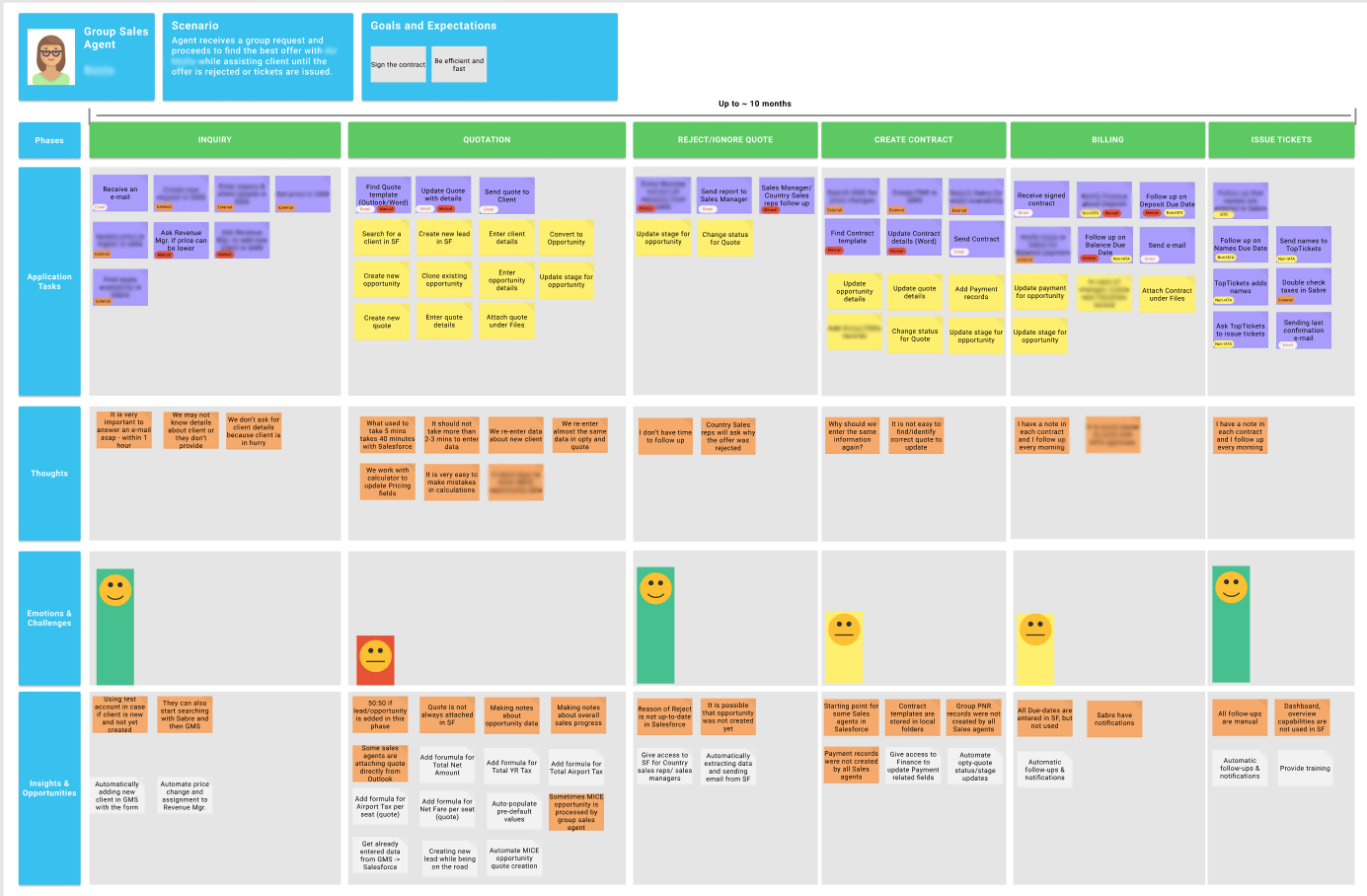
To make Salesforce CRM highly effective for business and ensure widespread user adoption, a great user experience (UX) is crucial. The optimal method to accomplish this is through a phased approach to UX design, which has demonstrated itself as the gold standard best practice.
This article will explore the different phases of improving Salesforce UX and discuss the advantages of partnering with external resources for UX design.
Five phases of improving Salesforce UX
Phase 1: Salesforce User Research
The first phase in the UX design process is user research. Gathering feedback and insights from end-users is vital to understand their needs, preferences, and pain points. Qualitative and quantitative research methods provide a comprehensive understanding of user workflows and allow for data-driven insights. By consolidating these insights into a User Journey Map, designers can start working on creating a cohesive and user-centric UX.

Example of User Journey map in the user research phase
Phase 2: Prototyping New Salesforce UX
After conducting user research, the next step is to create wireframe prototypes of new user workflows. These prototypes aim to enhance the look and feel, ease of use, and task completion time.
Streamlining the user interface, automating repetitive tasks, integrating with other systems, and leveraging AI capabilities can significantly improve the overall UX. Achieving these improvements requires a deep understanding of Salesforce capabilities and the company's IT infrastructure.
Phase 3: Testing the New UX Prototypes with Users
Testing the new UX prototypes with end-users is crucial to ensure it aligns with their needs, preferences and usage patterns. User testing provides valuable insights into the effectiveness of the design and helps identify any issues that need to be addressed before implementation. Additionally, involving subject matter experts and collaborating with the IT department ensures the design preserves essential functionality and aligns with business goals.
While skipping the prototype testing phase may seem like a good idea to expedite implementation, our experience with CRM systems from 2007 suggests that prototyping is essential to ensure that the UX meets user requirements and minimizes the risk of encountering user complaints once implementation is finalized. Many problematic UX improvement projects can be attributed to the absence of user testing for prototype UX before commencing the implementation process.
Despite extensive user research, testing the prototype may reveal discrepancies between how users say they want to use software and how they actually use it when tested.
Phase 4: Implementing the New UX
The fourth stage is the implementation of the new UX. This involves the configuration and customization of Salesforce. Implementation using an Agile methodology is recommended to allow users to test solutions and provide feedback at early stages.
Phase 5: Onboarding and Measuring Adoption
Salesforce platform features such as Welcome Mat, Walkthrough, and Feature Prompts are helpful tools supporting user onboarding and adoption.
It is important not to forget to measure the adoption and engagement of your users, and that can be achieved by creating Adoption Dashboards, preparing surveys, or running usability tests.
Choosing between Internal and External Resources
When deciding who will work on the UX design, companies have two options: hiring and training an internal team or partnering with a Salesforce Consulting Partner specializing in UX. While building an internal team may be justified for companies with a larger user base, partnering with an external resource is often the preferred choice for most companies.
Collaboration with a qualified Salesforce Consulting partner provides the following benefits:
- Access to extensive experience in solving UX challenges
- Acceleration of the development and implementation of Salesforce UX by leveraging existing design libraries and best-practice-based processes
- Reduction of project implementation risks
- Accelerate learning of internal team
While the number of Salesforce Consulting partners is high, the number of certified Salesforce UX professionals and partners specializing in Salesforce UX is rather limited.
When selecting a Salesforce Consulting partner, it's important to look for one whose employees have extensive experience in UX design in the CRM domain, ideally in other CRM products.
This ensures that they have a highly experienced team, refined UX design processes, and can accelerate development with existing design libraries and project accelerators.
It's also highly beneficial to choose a partner with deep technical competence in Salesforce and its integration with other business systems. This allows for a more holistic approach and leverages the company's other technologies to improve Salesforce UX.
Conclusion
Improving Salesforce UX requires a phased approach that includes user research, prototyping, testing, implementation, and user onboarding and measuring adoption.
Larger companies can develop their internal UX design capabilities over time. However, collaborating with experienced Salesforce Consulting partners is highly advantageous for smaller companies and those facing immediate UX challenges.
Working with external partners allows for faster UX improvements and the opportunity to leverage proven approaches and processes.
Are you interested in learning more about Salesforce User Experience improvement? You may want to read our latest publication Winning Over Users: A Guide to Improving Salesforce Adoption.
